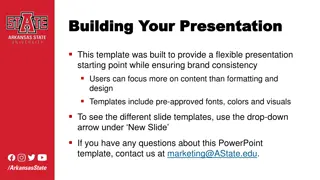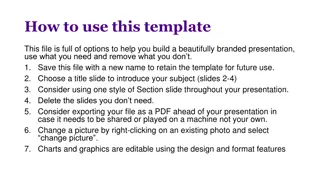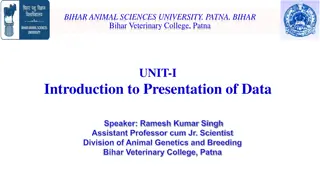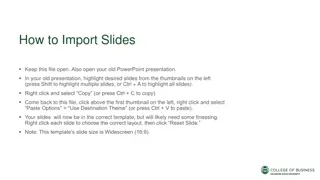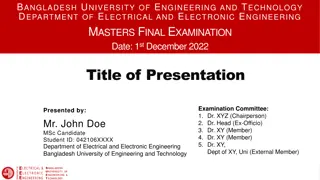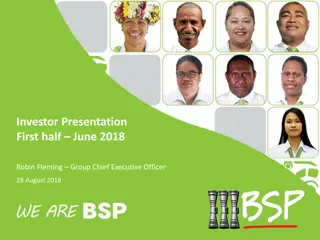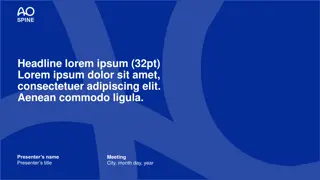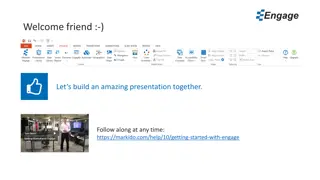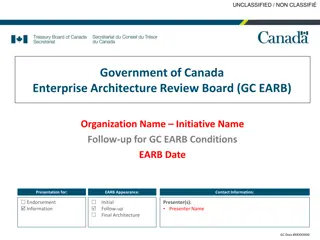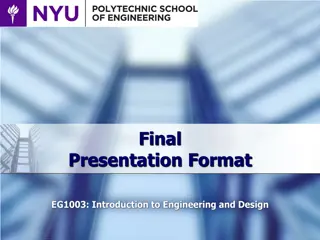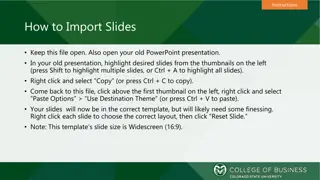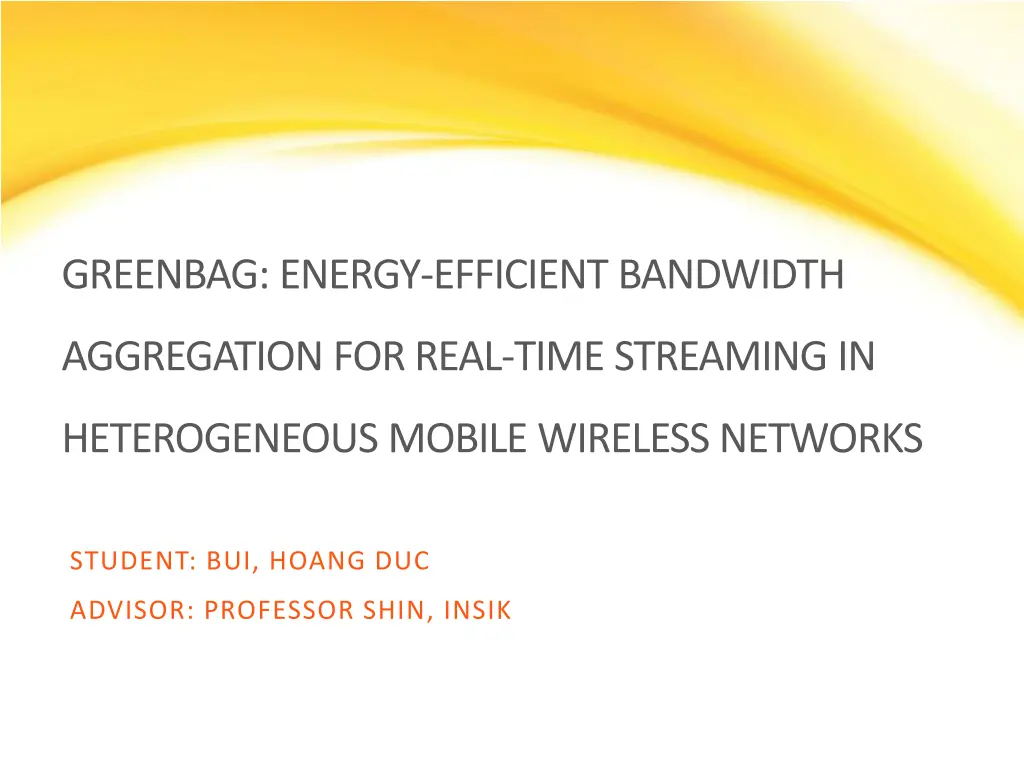
Energy-Efficient Bandwidth Aggregation for Real-Time Streaming in Mobile Networks
Explore how bandwidth aggregation can enhance mobile streaming performance, leveraging multiple network interfaces to boost bandwidth. Discover the potential of LTE and WiFi technologies for efficient multimedia streaming in heterogeneous mobile environments.
Download Presentation

Please find below an Image/Link to download the presentation.
The content on the website is provided AS IS for your information and personal use only. It may not be sold, licensed, or shared on other websites without obtaining consent from the author. If you encounter any issues during the download, it is possible that the publisher has removed the file from their server.
You are allowed to download the files provided on this website for personal or commercial use, subject to the condition that they are used lawfully. All files are the property of their respective owners.
The content on the website is provided AS IS for your information and personal use only. It may not be sold, licensed, or shared on other websites without obtaining consent from the author.
E N D
Presentation Transcript
GREENBAG: ENERGY-EFFICIENT BANDWIDTH AGGREGATION FOR REAL-TIME STREAMING IN HETEROGENEOUS MOBILE WIRELESS NETWORKS STUDENT: BUI, HOANG DUC ADVISOR: PROFESSOR SHIN, INSIK
MOTIVATION Mobile multimedia streaming is very popular today Real-time multimedia streaming traffic will take up to 66% of global mobile data traffic by 2017, up from 51% in 2012 [Cisco Systems Forecast] High quality video streaming needs high bandwidth Streaming ultra-HD 4K videos requires around 19Mbps bandwidth [Youtube] High definition cameras on modern smartphones are capable of recording 1080p full-HD videos at 17-24Mbps bit rates 2
BANDWIDTH AGGREGATION ON MOBILE DEVICES - OPPORTUNITY Increasing usable bandwidth by bandwidth aggregation: create one logical link via two physical links Common mobile phones are equipped with at least two network interfaces, 3G/LTE and WiFi LTE provides high bandwidth comparable to WiFi 3
BANDWIDTH AGGREGATION Bandwidth aggregation needs to divide the file downloading into the two different interfaces Divide the file into small segments and assign each segment to one of the links for downloading 4
BANDWIDTH AGGREGATION Bandwidth aggregation needs to divide the file downloading into the two different interfaces Divide the file into small segments and assign each segment to one of the links for downloading File 5
BANDWIDTH AGGREGATION Bandwidth aggregation needs to divide the file downloading into the two different interfaces Divide the file into small segments and assign each segment to one of the links for downloading File 6
BANDWIDTH AGGREGATION Bandwidth aggregation needs to divide the file downloading into the two different interfaces Divide the file into small segments and assign each segment to one of the links for downloading File LTE WiFi WiFi LTE LTE WiFi LTE WiFi WiFi WiFi 7
BANDWIDTH AGGREGATION Bandwidth aggregation needs to divide the file downloading into the two different interfaces Divide the file into small segments and assign each segment to one of the links for downloading Two basic problems must be solved Segment size decision Segment channel assignment File LTE WiFi WiFi LTE LTE WiFi LTE WiFi WiFi WiFi 8
BANDWIDTH AGGREGATION Bandwidth aggregation needs to divide the file downloading into the two different interfaces Divide the file into small segments and assign each segment to one of the links for downloading Two basic problems must be solved Segment size decision Segment channel assignment Important issue: out-of-order delivery We cannot use out-of-order segments for playing back which requires in-order data Out-of-order segment File LTE WiFi WiFi LTE LTE WiFi LTE WiFi WiFi WiFi Downloading in progress Downloaded portion 9
BANDWIDTH AGGREGATION ON MOBILE DEVICES REQUIREMENTS Strict energy saving requirement Mobile devices are powered by batteries The use of multiple network interfaces can introduce a significant energy usage LTE and WiFi have different power management Ease of deployment A widely applicable technique should require no change to the Internet infrastructure 10
GOAL Address the two basic problems in order to support the QoS requirements of real-time video streaming in the most energy-efficient way Segment size decision Segment channel assignment In this thesis, we consider only on-demand video streaming in which the video file size is known LTE WiFi WiFi LTE LTE WiFi LTE WiFi WiFi WiFi 11
PROBLEM FORMULATION Considering QoS satisfaction more important than energy saving, we formulate the multi-objective optimization problem as a lexicographic optimization Problem #1: Decide the size and channel assignment of each segment which minimize playback time P subject to throughput of LTE and throughput of WiFi Problem #2: Decide the size and channel assignment of each segment which minimize energy consumption E subject to throughput of LTE and WiFi, and ? = ? , where ? is the minimum playback time derived in optimization #1 0 1 ? ? 1 ???? ? ????? ?????????? 12
BANDWIDTH AGGREGATION ON MOBILE DEVICES CHALLENGES Link heterogeneity Out-of-order packet delivery Bandwidth fluctuation Accurate prediction of network condition is not possible Places Bandwidth heterogeneity in different places LTE bandwidth fluctuation 13
APPROACH: MULTI-LINK DATA STREAMING SCHEME Divide a file into segments, then divide each segment further into two subsegments, and assign each subsegment into one of the two interfaces for downloading ?1 ?2 In-order Data ?3 ?4 14
GREENBAG ARCHITECTURE GreenBag is a middleware which provides energy-efficient multi-link data streaming services GreenBag s role is as a proxy between video player and server GreenBag LTE Video Player HTTP Engine Download Engine Server Buffer WiFi Download Planner 15
GREENBAG ARCHITECTURE GreenBag is a middleware which provides energy-efficient multi-link data streaming services GreenBag s role is as a proxy between video player and server GreenBag LTE Video Player HTTP Engine Download Engine Server Buffer WiFi Download Planner Energy-aware Link Mode Chooser Recovery Decision Maker Medium Load Balancer Segment Manager Goodput Predictor Energy Model Video Player State Monitor 16
COMPONENTS OF DOWNLOAD PLANNER (1/5) Segment Manager Determine the next segment size when a segment completes It uses a fixed segment size in typical cases Overhead of requesting a segment is small because of the use of HTTP pipelining Download Planner Energy-aware Link Mode Chooser Recovery Decision Maker Medium Load Balancer Segment Manager Goodput Predictor Energy Model Video Player State Monitor 17
COMPONENTS OF DOWNLOAD PLANNER (2/5) Medium Load Balancer Determine the subsegment sizes and links assignment in the next segment Basing on unfinished portion size, next segment size, and estimation of current goodput Reduce out-of-order delivery Both interfaces would finish at the same time The faster link would download the earlier subsegment Require good estimation of current goodput Download Planner Energy-aware Link Mode Chooser Recovery Decision Maker Medium Load Balancer Segment Manager Goodput Predictor Energy Model Video Player State Monitor 18
COMPONENTS OF DOWNLOAD PLANNER (3/5) Recovery Decision Maker Handle the case when goodput estimation is wrong Replan the downloading again When GreenBag made poor decisions on load balancing due to fast fluctuation of network bandwidth, such as a drop of WiFi bandwidth Download Planner Energy-aware Link Mode Chooser Recovery Decision Maker Medium Load Balancer Segment Manager Goodput Predictor Energy Model Video Player State Monitor 19
COMPONENTS OF DOWNLOAD PLANNER (4/5) Energy-aware Link-mode Chooser Download Planner Energy-aware Link Mode Chooser Recovery Decision Maker Medium Load Balancer Segment Manager Goodput Predictor Energy Model Video Player State Monitor 20
LTE POWER MANAGEMENT LTE power management has 3 states: ACTIVE, TAIL, and IDLE LTE interface in TAIL state has high power consumption, about half of the power in ACTIVE state The TAIL state timeout ????? is long (11.2 seconds) Suggests to keep LTE idle long enough until LTE interface demotes to IDLE state which consumes almost no energy ACTIVE ACTIVE no data traffic TAIL any data traffic any data traffic ????? IDLE TAIL IDLE TAIL state timeout expires (a) LTE power states (b) LTE power trace 21
COMPONENTS OF DOWNLOAD PLANNER (4/5) Energy-aware Link-mode Chooser Save energy by keeping LTE idle in long period (longer than ?????) Avoid irregular data transfer over LTE which prevents LTE to enter IDLE state Choose the link mode that consumes the least energy to download the remaining portion of the file without incurring any playback interruption Three link modes: Dual-link, LTE-only, and WiFi-only Download Planner Energy-aware Link Mode Chooser Recovery Decision Maker Medium Load Balancer Segment Manager Goodput Predictor Energy Model Video Player State Monitor 22
COMPONENTS OF DOWNLOAD PLANNER (5/5) Goodput Predictor Predict goodput of each link in the remaining portion of the file using an exponential weighted moving average (EWMA) predictor Video Player State Monitor Monitor the video player s current state and position Download Planner Energy-aware Link Mode Chooser Recovery Decision Maker Medium Load Balancer Segment Manager Goodput Predictor Energy Model Video Player State Monitor 23
DOWNLOAD PLANNER - DECISION MAKING Typically, GreenBag makes the following decisions to download further when a link is going to finish its subsegment Decide to recover or not, if not Decide the next segment size Choose the most energy-efficient link mode Decide the subsegment sizes of the two links in the next segment Download Planner Energy-aware Link Mode Chooser Recovery Decision Maker Medium Load Balancer Segment Manager Goodput Predictor Energy Model Video Player State Monitor 24
EVALUATION Evaluation in real-world networks Evaluation in emulated environment 25
EVALUATION IN REAL-WORLD NETWORKS EXPERIMENT SETUP (1/2) Compare 4 configurations (GB-E, GB-P, LTE-only, and WiFi-only) in 3 scenarios (Stationary #1, Stationary #2, and Mobile) in terms of 2 performance metrics Two performance metrics Playback time Energy consumption Four configurations GB-E: GreenBag-Energy mode, supports QoS while saving energy GB-P: GreenBag-Performance mode, maximizes throughput without saving energy LTE-only (WiFi-only): video streaming using only LTE (WiFi) 26
EVALUATION IN REAL-WORLD NETWORKS EXPERIMENT SETUP (2/2) Compare the 4 configurations (GB-E, GB-P, LTE-only, and WiFi-only) in 3 scenarios (Stationary #1, Stationary #2, and Mobile) Three scenarios Stationary #1: Bandwidth of LTE is always greater than of WiFi Stationary #2: Bandwidth of LTE is always smaller than of WiFi Mobile: WiFi bandwidth fluctuates fast and has a drop due to user mobility Stationary #1 Stationary #2 Mobile Average LTE bandwidth (Mbps) 5.14 4.12 4.73 Average WiFi bandwidth (Mbps) 3.85 5.00 4.94 Total average bandwidth (Mbps) 8.99 9.12 9.67 Experimented video has 6.1Mbps average bit rate, and is 117 seconds long 27
28 PERFORMANCE OF GREENBAG IN REAL-WORLD EXPERIMENTS GreenBag minimizes video interruption time GB-E not only minimizes video interruption time but also consumes 14-25% less energy than GB-P
DEMONSTRATION PLAYBACK TIME MINIMIZATION PlayTime.mp4 Please visit the following website for the video file http://cps.kaist.ac.kr/greenbag/ 29
DEMONSTRATION ENERGY SAVING EnergyConsumption.mp4 Please visit the following website for the video file http://cps.kaist.ac.kr/greenbag/ 30
EVALUATION IN EMULATED ENVIRONMENT Experiment setup Emulated network A client, a server, and an intermediate node equipped with network emulator tools Emulated player Implementation of the video player model Evaluate four aspects of GreenBag Segment size overhead Effectiveness of adaptive load balancing Effectiveness of recovery mechanism Effectiveness of energy-aware link mode switching 31
VIDEO PLAYER MODEL The video player is modeled as a queue in front of the video decoder Arrived data: ?(?) Decoded data: ?(?) Buffered data: ?(?) ? ? = ? ? ?(?) Video Buffer A(t) D(t) Data Source Video Decoder X(t) B Data size L Video playback starts when data in the buffer is sufficient: ? ? ? B is called lower threshold B k-th bit Video player pauses when buffered data ? ? decreases to zero X(t) B A(t) D(t) Time t4 t0 t1 t2 t3 32
SEGMENT SIZE OVERHEAD Optimal segment sizes are independent of bandwidth heterogeneity and video bit rates Small segment size imposes more overhead in requesting every new segment Large segment size increases out-of-order data delivery ???????????? ????????????? (a) Overhead in different link heterogeneity (b) Overhead in different video bit rates 33
EFFECTIVENESS OF ADAPTIVE LOAD BALANCING Bandwidth heterogeneity has little effect on the performance of the adaptive load balancing scheme, while affecting the fixed load balancing (1:1) significantly 34
EFFECTIVENESS OF RECOVERY MECHANISM (1/2) Recovery mechanism avoids the long out- of-order data caused by bandwidth drops E.g. WiFi bandwidth can drop when the smartphone moves out of WiFi coverage 35
EFFECTIVENESS OF RECOVERY MECHANISM (2/2) Recovery mechanism keeps playback time minimum even in the presence of multiple of bandwidth drops 36
EFFECTIVENESS OF ENERGY-AWARE LINK- MODE SWITCHING GB-E provides the same playback time with GB-P, while saving 2%-40% of energy consumption of GB-P ???????????? ????????????? 37
CONCLUSION The thesis has the following contributions 1. Formulate bandwidth aggregation for real-time video streaming as a lexicographic optimization 2. Design a multi-link data streaming middleware to support real-time delivery in the most energy-efficient way 3. Implement a prototype of GreenBag on Android-based mobile devices equipped with LTE and WiFi interfaces To the best of our knowledge, this is one of the first LTE- enabled prototypes which demonstrates the effectiveness of bandwidth aggregation for energy-efficient real-time delivery on mobile phones 38
ACKNOWLEDGEMENT I would like to express my special thanks and appreciation to Kilho Lee, Sangeun Oh (Cyber-Physical Systems Lab), Doctor Hyojeong Shin (Mobile SW Platform Center), Doctor Honguk Woo, and Doctor Daehyun Ban (Samsung Electronics) for their great support and collaboration in the research 39
THANK YOU QUESTIONS AND ANSWERS
APPENDIX ENERGY MODELS OF LTE AND WIFI Transmission energy used to download ? Mbits with bandwidth ? Mbps is formulated as ????,? = ? ? + ? ? ? (??) ? ? + ? : power consumption; ? ?: time for downloading data LTE WiFi ? 16.72 24.19 ? 2022.20 360.90 Energy consumption in TAIL state of LTE: ?????= ????? ? Power consumption in TAIL state: ?????= 1350.0?? ? is the duration in which LTE is in TAIL state We ignore promotion, and data upload energy values, because they are too small 41

